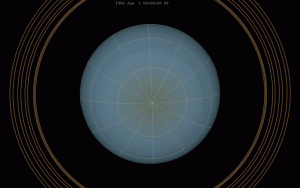This animation shows the aspect the planet Uranus will present to Earth through the year 2030. Uranus lies almost on its side, so as it orbits the Sun, first one pole and then the other aims at the Sun. That creates seasons that are quite different from those on Earth. (The animation also shows the planet's thin dark rings.) [Tomruen/Wikipedia]
You are here
Uranus at Opposition
Like Earth, most of the other planets in our solar system have seasons. And also like Earth, the seasons are caused by a planet’s tilt on its axis.
The planet with the oddest tilt is Uranus. It’s the Sun’s third-largest planet — four times the diameter of Earth. When it was young, it was knocked over on its side — perhaps by a collision with a planet as big as Earth. So instead of aiming roughly up and down, Uranus’s poles aim sideways, along the plane of the solar system.
Uranus takes 84 years to orbit the Sun, so each season lasts a quarter of that — 21 years. During northern winter, the north pole aims toward the Sun, so it sees 21 years of sunlight. During southern winter, it’s the south pole that sees constant sunlight. And between those seasons, the Sun passes above the equator, creating spring and fall.
Spring arrived in the planet’s northern hemisphere back in 2007. The season will continue until 2028 — the beginning of the northern winter on this giant planet.
And Uranus is putting in its best showing of the entire year about now. It’s lining up opposite the Sun, so it rises around sunset and remains in view all night. It’s in a fairly empty patch of sky, near the intersection of the constellations Aries, Pisces, and Cetus.
Uranus is brightest for the year, too. Under especially dark skies, in fact, it\'s just visible to the unaided eye. Most of us, though, will need binoculars to find this tilted giant, shining like a tiny blue-green star.
Get Premium Audio
Listen to today's episode of StarDate on the web the same day it airs in high-quality streaming audio without any extra ads or announcements. Choose a $8 one-month pass, or listen every day for a year for just $30.




